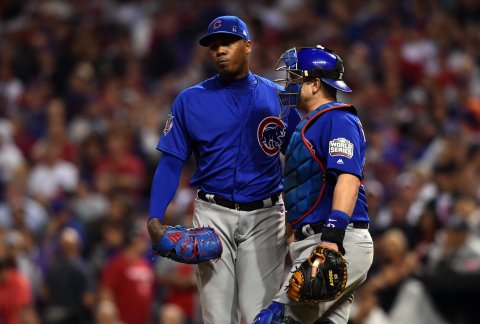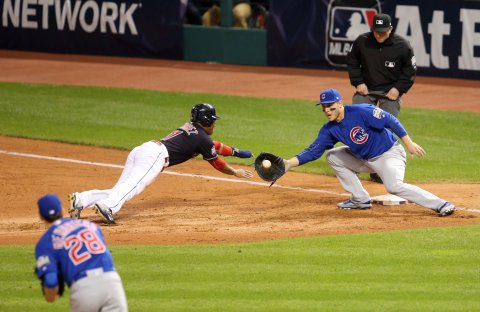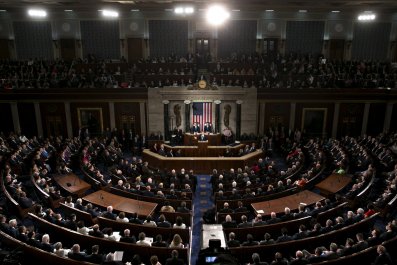Yogi Berra, baseball's inscrutable sage, once said of left field at Yankee Stadium, "It gets late early out there." The same can be said of the national pastime, whose games last year for the first time eclipsed the three-hour mark, on average. "Pace of play is an issue that we need to be focused on,'' Rob Manfred, the baseball commissioner, recently told USA Today. The "we," he said, includes "players, owners, umpires...everyone who is invested in this game."
For most of its first sesquicentennial, Major League Baseball (MLB), which began play in 1869, was blithely indifferent to time management. Hell, the Chicago Cubs waited 108 years to win a World Series. Baseball games were to other sporting events what Paul Thomas Anderson movies are to other films. Brevity was immaterial. What would you expect from an endeavor invented by a man named Doubleday?
Baseball's unofficial anthem, "Take Me Out To The Ballgame," was written in 1908. The song's authors, Jack Norworth and Albert Von Tilzer, introduced the tune in the midst of a halcyon era when those Americans with an appetite for sport and the means to enjoy it attended 24-hour bicycle races and heavyweight bouts that lasted 49 rounds. The only thing people binge-watched in 1908 were sunsets.

"I don't care if I ever get back?" When Norworth and Von Tilzer wrote "Take Me Out…," neither of them had ever been to a baseball game. What did they know about baseball's intrusion on one's schedule? It's not as if Norworth and Von Tilzer had already plunked down $34 for a SoulCycle class at 7 a.m. the next day.
Baseball games are too damn long, especially in a 21st century age of mutually assured distraction. In 1920, the first year from which there is ample data to record this statistic, a typical game lasted 1:47. Last year the average game ran 3:02, which is a respectable time...if you are running a marathon.
"If you put a clock on baseball, you take away the sanctity of the game and the character of it," Texas Rangers catcher Jonathan Lucroy recently told USA Today. "The game has been played like this way for 150 years, and now we're going to change it?"
Lucroy is half-right: the game's template has not changed for 148 seasons, but to think that its pace has not lost a certain alacrity is to be unfamiliar with baseball's past. In 1920—and even back in 1869—a game lasted nine innings, with 27 outs for each team, and it remains so today. However, baseball games take 70% longer to complete now than when Woodrow Wilson was president (and it isn't all television's fault). Manfred recently instituted a rule, to take effect this season, that the intentional walk will no longer require four pitches. Instead, a signal will come from the dugout. That this signal is not a giant photo of former reliever Grant Balfour is due to a lack of imagination from the commissioner's office.

Naturally, Manfred is facing brushback from players and traditionalists alike, as if he's crowding the plate with his proposals (he also wants a 20-second pitch clock, which has been used in the minor leagues since 2015). Don't blame him. Baseball has placed itself in a force-out predicament.
Related: Baseball can't be America's pastime until it lets women play
The longest nine-inning, no-rain-delay regular-season games in both National League (4:30 in 2016) and American League (4:45 in 2006) history have taken place in the past dozen years. That is not a coincidence. If baseball wants to keep the attention of fans, it would help to return contests to the 2:30-2:45 range, and in order to do that, change must take place. In a game so rooted in tradition, it is only natural that any proposed alteration will be met with resistance.
However, players and traditionalists should note that five of the past six Indianapolis 500s were run in less time than a typical game last year. And the Indy 500 still offers spectators the suspense of a potential collision, which baseball has outlawed (at home plate). With the hope that baseball's stewards and connoisseurs will digest these ideas with open minds, here are five suggestions for picking up the pace of baseball. (By the way, in a typical day, with all 30 teams playing, there are on average only five intentional walks issued; we'd not mess with that aspect of the game.)
One Free Throw to First Base Per Baserunner: When a runner is on first, the pitcher can throw over once. Each throw after that will be counted as a ball in the hitter's count. This does not eliminate strategy; it actually enhances it. The pitcher can no longer indiscriminately play catch with the first baseman as the cascade of boos (particularly if he throws for the visiting nine) builds. Besides, what is the difference between a called pitchout and a pitcher simply wasting a ball on a second throw to first base? This rule does not eliminate a pitcher's ability to hold the runner on first; it simply compels him to be more judicious.

The purists love to refer to this cat-and-mouse moment as "the game within the game," but when the game is already three hours in duration, how badly do we need an auxiliary one?
Make the Batter's Box an In-Box: When a batter steps into the batter's box, he must remain there unless the previous pitch resulted in a foul ball, wild pitch or passed ball. If he is nearly hit by a pitch, he may leave the box, but only with the umpire's permission. The penalty for leaving the box otherwise is one strike against the batter. Likewise, the pitcher must remain on the rubber after each pitch except for the aforementioned foul ball, etc. The penalty for leaving the rubber is one ball awarded to the batter.
The 20-Second Pitch Clock: Since the batter has to remain in the box, the pitcher must throw to the plate in a timely fashion. Pitchers rarely exceed this time-limit any way. It would simply prevent pitchers from making hitters antsy.
Curtail Summit Meetings: As the pitcher's mound is the highest ground on any ballfield, every conference that takes place there is a summit meeting. These take place entirely too often, especially considering that many are confabs in which there is no common tongue between the battery mates. Here's the deal: one pitcher-catcher meeting per pitcher per game (failure to comply puts the batter on first base) and one pitching coach or manager visit to the mound per pitcher per game. We've all seen Bull Durham and we know they're just discussing wedding gift ideas, anyway.
Eliminate the Sixth Inning: Mostly kidding, but if skyscrapers can scrape skies without a 13th floor, why can't baseball games be complete without a sixth inning? You need five innings for a game to be official, while managers prioritize their bullpen staff based on the final three innings (before I forget, the reliever will now be given three warm-up pitches upon entering the game as opposed to eight). The sixth inning is a bridge inning, and who pays to see middle relievers, anyway? Right away we've eliminated 11% of the length of a game, or roughly 19 minutes. You could adopt this rule and not need to alter anything else.
"I don't think there's a magic bullet that is going to come one year and that's going to be the solution to pace of play," Manfred told USA Today. Perhaps not, but it is past time that the national pastime confront its laggard pace. If it doesn't, soon umpires will cry, "Play ball!" and fans will shout back, "Faster!"





















